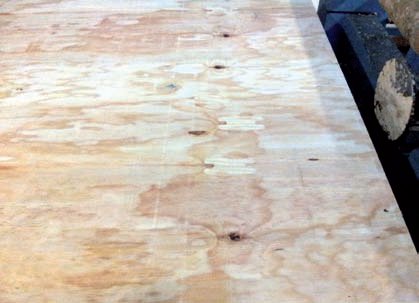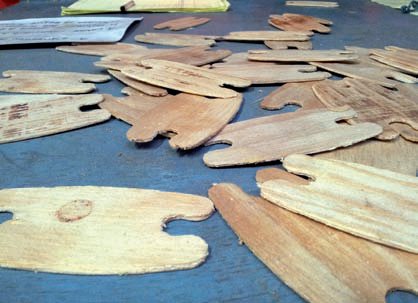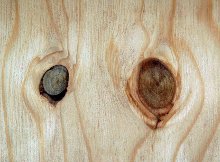The story of knots
17 November 2014The appearance of knots in sawn wood and veneer is caused by grain deviation to accommodate the wood found inside the branches of trees.
As the tree grows taller, the crown shades older and lower branches so they tend to die off and are subsumed by the increasing girth of the trunk.
Clear wood, ie knot-free, can be found in the outer parts of the trunk wood. The central inner part of the trunk will still contain knots from branches for med when the tree was young. These knots will be 'dead' knots. Their wood tends to be much darker and, sometimes, the knot will fall out, leaving a hole.
Live knots on the other hand tend to have a similar colour to the trunk wood, all be it a little darker. They are stronger than dead knots.
Figure 1 (right) shows a veneer that has both a dead and a live knot almost side-by- side.
The rotary peeling of logs to veneer exposes the underlying structure of a tree trunk. Once the log has been rounded by the lathe a continuous ribbon of veneer is formed. At first, the veneer is clear, with no knots, but, as the log diameter is reduced, regular knot patter ns begin to emerge, caused by the branches for med much earlier in the life of the tree.
In general, the market prefers uniformly coloured panels, especially if a finish is to be applied to the surface. Veneers are therefore graded in terms of their colour and the presence of defects such as knots. Clear sheets will be used for the surface layers to maximise the value of the final panel.
Unfortunately, the majority of veneer sheets have one or more defects, so they must be improved to increase their value.
One method which is very commonly used is patching, whereby the defect is stamped out by a die and replaced with a similarly-shaped piece of clear veneer (see Figure 2).
The patches are initially held in place by friction, because the patch is the same size as the hole. Later the patch is kept in place by the glue between the veneers.
The majority of plywood factories around the world use trained operators to identify and punch-out defects, but Automation of this step is creeping in, especially in factories which process just one wood species and/or those where the defects have a high contrast relative to the clear wood. This is the case in Figure 1; the knots are appreciably darker than the clear wood. Within a factory, just one size and shape of patch will be used. There is no attempt to match a patch, in terms of colour and figure, to the surrounding veneer. Despite this, it is surprising how often the patches blend into the look of the veneer.
Dear reader, do please send me any photographs that you might have of veneer patches as I would like to show my students the range of patch sizes and shapes that are used around the world.


